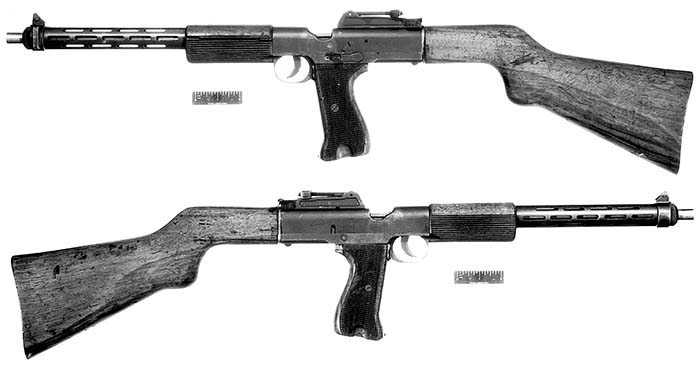By Finn Nielsen
Some time ago I had the opportunity to examine a submachine gun held in a private collection. Having owned or operated most of the common mass produced versions of these wonderful firearms for over thirty-five years, this one was not familiar at all. The ‘D’, ‘E’ and ‘S’ markings on the left side of the receiver obviously indicated German or Austrian origins. The wood furniture and quality of workmanship strongly suggested a time period between World War I and World War II. In other words, a second generation firearm. Unfortunately, the magazine and the recoil/return spring were missing which negated test firing, however, the following could be deduced from the available physical evidence the firearm itself:
It was 9mm Parabellum caliber, no surprise there. It fired from an open bolt. The magazine appeared to have been the type used in an MP-34 or 53 submachine gun, judging by the shape of the magazine well.
The receiver was slotted for re-filling the magazine with a stripper clip. Its barrel moved back slightly upon firing to unlock the bolt, extracting and ejecting the fired cartridge case. Barrel length 12 1/2”, overall length 30 1/2”. The rear sight was very similar to an MP-28 sight
This system of recoil operation will certainly help keep the weight of the moving parts down, but one can only wonder how long fragile parts such as an extractor will last. The rate of fire must have been fairly high, but without knowing the strength of the barrel spring, and the recoil/return spring not the weight of the bolt I wouldn’t even hazard a guess. This firearm may well have been designed as a ‘project’ by an employee of a German /Austrian arms factory. It exhibits a great deal of handwork especially in the many individual welds used to construct the pistol grip assembly. It must also have been difficult to cock with the bolt locking into the barrel. In fact, a rather crudely welded crossbar has been added to the original serrated ‘cocking piece’. It does not appear to have original, but added later somewhat hurriedly.
How it reached North America has been lost to us, probably the customary soldier souvenir route. If it rings a bell with anyone I would like to know. Perhaps one of our advanced North American collectors might know, or a European reader!

| This article first appeared in Small Arms Review V1N9 (June 1998) |











